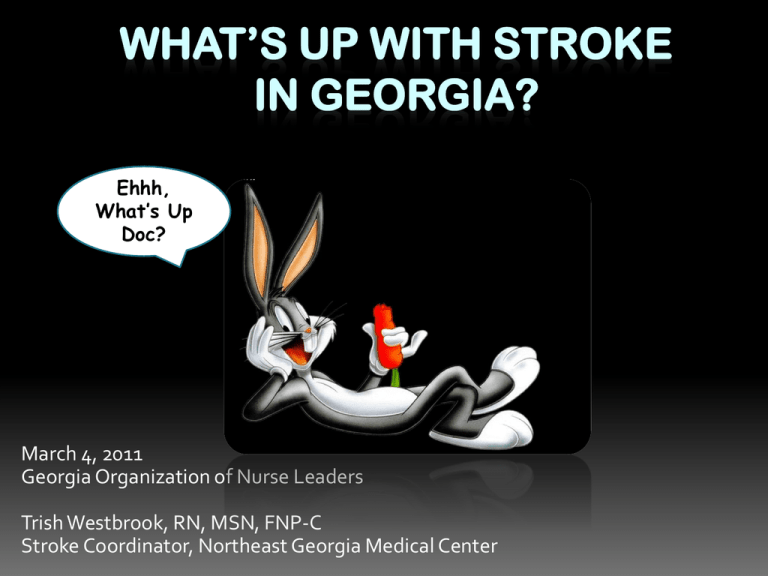
WHAT’S UP WITH STROKE
IN GEORGIA?
Ehhh,
What’s Up
Doc?
March 4, 2011
Georgia Organization of Nurse Leaders
Trish Westbrook, RN, MSN, FNP-C
Stroke Coordinator, Northeast Georgia Medical Center
Where have we been?
Where are we going?
Bugs Bunny is now 71 years old !
Looking good, but increased stroke risk
What are Bugs’ risk factors?
What healthy habits does Bugs have to help
prevent stroke?
Where have we been?
Where are we going?
In the past, only treatment for stroke
was supportive care
In 1996 the FDA approved Activase
(alteplase) for treatment of acute ischemic
stroke
This was a game-changer for the treatment of stroke
Must be given within 3 hours of onset (expanded
window now up to 4 ½ hours)
Physicians & hospitals were slow to adopt this
treatment
But then things began
to change
Kickoff of Coverdell Stroke Registry
Sen. Paul Coverdell – died of a massive stroke in 2000
Coverdell Registry partners with American
Heart/Stroke Association’s “Get With the Guidelines”
(GWTG) program
Timeline
Pilot began with four states – GA, IL, MA, NC – 2001
Additional states piloted in 2003
Georgia began with 26 hospitals in 2005 – now 60
hospitals
State implementation in 2004
Building Consensus
Goal was to improve the care of acute stroke in
hospitals
Coverdell & GWTG advocate:
Evidence-based guidelines
Use of standardized order sets
Primary and secondary prevention
Ongoing research
Different registries, different measures
Finally AHA, CDC, and TJC agreed on 10
“harmonized measures”
“Harmonized “
Stroke Measures
Thrombolytic Therapy Administered
Dysphagia Screening *
DVT / VTE Prophylaxis
Antithrombotic Therapy by Day 2
Anticoagulation for A-fib/A-flutter
Smoking Cessation *
Stroke Education
Assessed for Rehabilitation Needs
Discharged on Cholesterol Reducing Therapy
Discharged on Antithrombotics
*Measures temporarily suspended in 2010
“Get With the Guidelines Stroke” and Outcome Sciences
GWTG-S is a product of American Heart /
American Stroke Association
Robust and comprehensive registry & database
Used by researchers for many studies and
evidence-based guidelines
As of March 2011
1927 hospitals participating
1.6 million records entered
Location of hospitals in Georgia
GCASR- Georgia Coverdell Acute Stroke Registry
Number of Primary Stroke
Centers certified by TJC
1 - 10
11 - 20
21 - 30
31 - 50
51 +
Primary Stroke Centers
in Georgia
Athens Regional MC
Atlanta Medical Center
Coliseum MC
Doctors Hosp. of Augusta
Emory Eastside MC
Emory University Hosp.
Floyd MC
Grady Memorial Hosp.
Gwinnett MC
Habersham MC
Hamilton MC
MCG Health MC
Memorial Health (Savannah)
North Fulton MC
Northeast Georgia MC
Northside Hosp, Forsyth
Northside Hosp.
Piedmont Hosp.
Redmond Regional MC
Saint Joseph’s Hosp.
South Fulton MC
Southern Regional MC
Spalding Regional MC
St. Francis Hosp. (Columbus)
St. Joseph’s Hosp. (Savannah)
St. Mary’s HC System
The MC of Central Georgia (Macon)
The Medical Center (Columbus)
WellStar Cobb Hosp
WellStar Kennestone Hosp
Stroke Systems of Care
Emergency
Medical
Services
Community
Support &
Reintegration
Remote
Treatment
Centers
Rehabilitation
Primary
Stroke
Centers
Comprehensive
Stroke Centers
Georgia is in the “Stroke Belt”
Cardiovascular Risk Factors:
Georgia in 2007 . . .
10% - diabetes
19% - smoke
30% - high blood pressure
37% - high cholesterol
65% - overweight/obese
75% - no regular exercise
Georgia’s stroke death rate is 16% higher than U.S. average!
Obesity is a national epidemic
But your arteries aren’t !!
Other Stroke Projects in Georgia
The Coverdell-Murphy Act
Passed by Georgia Legislature in 2008
Dramatically changed approach of stroke care in GA
Established two-tier system for stroke-ready hospitals
Primary Stroke Centers (certified by TJC)
Remote Treatment Centers (designated by EMS)
Unfortunately no funding provided by the state to
finance efforts, so progress has been slow.
Just last week, language in guidelines changed to
include DNV and/or other certifying bodies to
designate Primary Stroke Centers
Georgia Stroke Professional
Alliance (Ga-SPA)
Voluntary grass-roots organization
Began with 7 Atlanta Stroke Coordinators in 2008
Now over 160 members throughout Georgia
Seeking incorporation as a non-profit
Georgia Stroke Professional
Alliance (Ga-SPA)
Mission is to prevent stroke and optimize stroke care
through professional networking and education.
Meet quarterly – rotate sites
Website: http://share.nghs.com/gastroke/
Activities
Network of stroke professionals
Support peers in developing stroke programs, achieving
certification
Promote evidence-based practice
Professional education
Community education, screening
Support legislation to improve stroke care
Is All This Effort Working?
Yes !!
For the first time in more than 50 years,
stroke has decreased in ranking as a cause of
death
From 3rd to 4th leading cause of death (switched
places with chronic lower respiratory disease)
Remains the leading cause of disabillity in
older adults
The Future of Stroke in Georgia
The Future . . .
Competition - evolving to collaboration
True “Stroke Systems of Care”
Telemedicine, telestroke
When Coverdell-Murphy network fully
established, non-stroke hospitals may be
bypassed
Funding for PSC coverage in south Georgia
(fingers crossed)
Joint Commission
Three tier system
Comprehensive Stroke Centers
Primary Stroke Centers
Acute Stroke Capable Hospitals
Standards development for Comprehensive
Centers will begin Q3 CY2011
Product launch: late 2012








